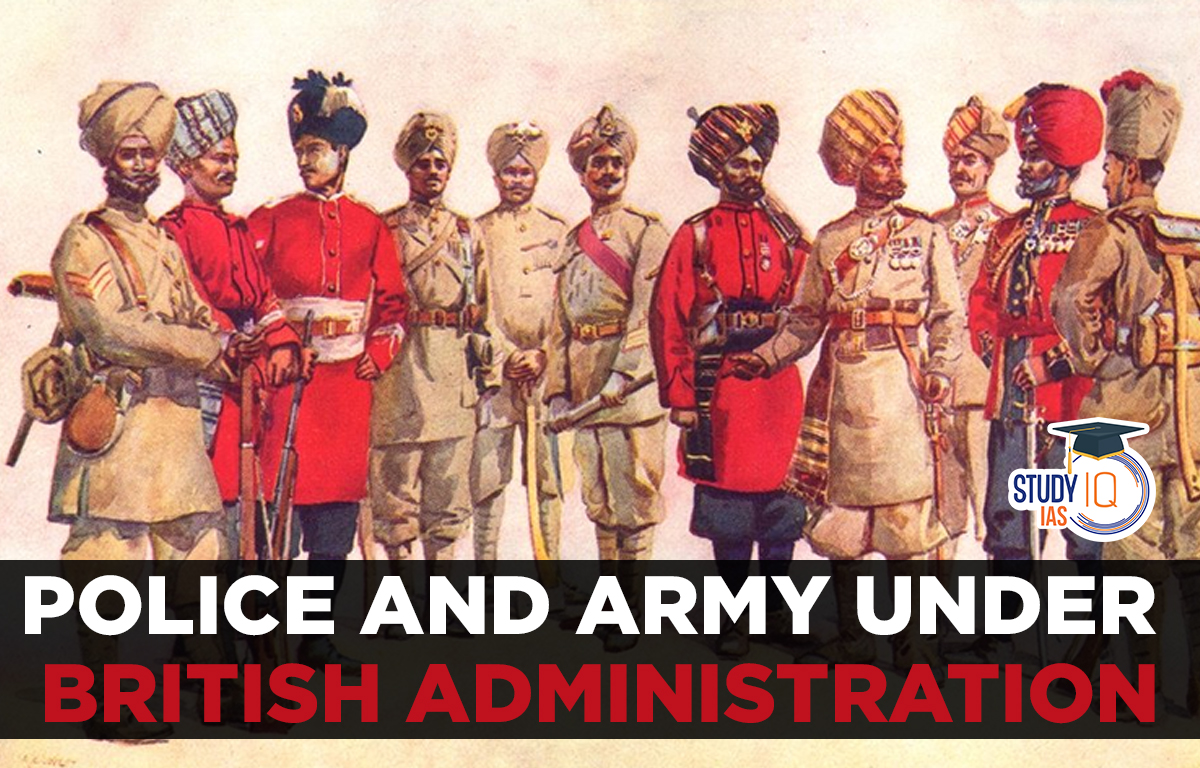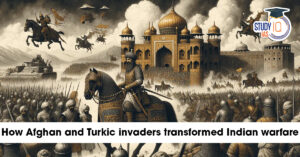Table of Contents
Army and Police under British Administration
Read all about Army and Police under British Administration. Learn everything there is to know about the British-run army and police. The army was the second-most crucial component of the British government in India. It carried out four essential tasks. It served as the principal weapon for extending and defending the British Empire in Asia and Africa. It also served as the major weapon for defending the British Empire in India against foreign rivals and the constant threat of internal uprising.
The police force, which was once again established by Cornwallis, served as the third pillar of British rule. He created a regular police force to uphold law and order and gave zamindars control over police duties. In this way, he updated the traditional thanas system from ancient India. India was now in front of the United Kingdom, which had not yet established the police force. This article has all the details about Army and Police under British Administration for the students preparing for UPSC.
Read More: Civil Service under British Administration
Army under British Administration
The land-based arm of the Indian armed forces is known as the Indian army. Of India’s three militaries, it is the largest (army, air force, and navy). The Indian army’s main duty is to protect the country from both internal and external threats. It maintains internal tranquilly and national security. During natural calamities, the Indian army often participates in humanitarian missions and rescue efforts.
The head of state of India is the army’s highest command. A four-star general serving as Chief of Army Staff is the official leader. The five-star rank of Field Marshal has only been awarded to two officers thus far. “Service before self” is the Indian Army’s motto.
Every year on January 15, people commemorate the day that Field Marshal Kodandera M. Cariappa took over as Commander in Chief of the Indian Army from General Francis Roy Bucher in 1949.
Read More: British Administration System
1. Army under British Administration History
Up until India’s independence, the British held leadership of the Indian Army. Locally recruited soldiers and British officers served in it. The British Indian army participated in several conflicts such as the Anglo-Burmese War, the Anglo-Sikh War, the Anglo-Afghan War, the Opium Wars, the Boxer Rebellion in China, and the Abyssinian War, so assisting in the upkeep of British dominance.
2. Army under British Administration Evolution
In the year 1776 in Kolkatta, the East India Company established a military department. The Bengal, Bombay, and Madras Presidency Armies were combined to become the Indian army in 1895. It was divided into four commands: Bombay, Bengal, Madras (including Burma), and Punjab (Northwest Frontier) (with Sindh, Quetta, and Aden).
In order to educate the children of aristocratic and wealthy Indian families and to prepare some Indian boys for admission to the Royal Military College, Sandhurst, the Prince of Wales Royal Indian Military College was founded in Dehradun in 1912. After graduating, cadets received a King’s commission and were assigned to one of the eight units chosen for Indianization.
In the year 1914–18 of the 1.3 million Indian soldiers who served in World War I, 74,187 were killed or reported missing in action. They made contributions to the battle theatres in Europe, the Mediterranean, the Middle East, and Africa. In the year 1939–1945 Indian soldiers fought alongside the Allies in World War II. Without their consent, the Indians had been forced into the fight. Demands for complete freedom in response have resulted from this.
Throughout the battle, several Indian soldiers switched sides to support the foreign independence effort. Many people joined the Free India legion in Germany as a result of this. The Indian POWs joined Subhash Chandra Bose’s Indian National Army in Singapore.
Police under British Administration
The police force, which was once again established by Cornwallis, served as the third pillar of British rule. He created a regular police force to uphold law and order and gave zamindars control over police duties. In this way, he updated the traditional thanas system from ancient India. India was now in front of the United Kingdom, which had not yet established the police force.
1. Police under British Administration History
In India, a professional police bureaucracy was established by the British with the Indian Councils Act of 1861. Consequently, the Superior Police Services were founded (later renamed Indian Imperial Police). In this instance, the Inspector General oversaw the provincial police system. The Superintendents of Police were in charge of the districts that made up the provinces. By nomination, the recruitment process was carried out. There were two ways to do this: either officer from the British Army were selected, or younger sons of the British landed gentry were appointed.
2. Police under British Administration Evolution
The first investigation into police abuse begins in 1855. A three-person committee was established in the Madras Presidency to look into suspected incidences of torture. 1860 saw the founding of the first Police Commission. An idea from the 1860 committee served as the foundation for the 1861 Police Act. Because it occurred so soon after the Sepoy Mutiny of 1857, it was dictatorial in nature. At the Center, this law is still in force today.
According to this act, the state government has control over the police force. The Chief or the Home Minister appoints the Commissioner of Police. Most of the time, the police are not directly answerable to democratic entities like civil society. Transfers of officers who resist political involvement are common.
3. Police under British Administration Reforms
After a great uprising against British rule by various sectors of Indian society in 1857, the British came to understand the urgent need for a regularized institution to govern the vast territory they had conquered. The creation of “civil” police forces was intended to lessen what, by the late 1980s, had become a dangerous reliance on the army for internal policing.
A Police Commission was founded in 1860. The Commission’s objective was to restructure the police force to increase its effectiveness and efficiency. The Commission recommended doing away with the military police in favor of establishing a single, uniformed civil police force that would report to the administration of each province. As a result, the Police Act (Act V) of 1861 was passed. It serves as the foundation for the modern Indian police force.
4. Police under British Administration 1861 Police Act
On March 22, 1861, the Indian Police Act, which had been enacted on March 16th, became law. A civil constabulary was to take over policing from the military police, and each province would have its own independent administrative structure with an inspector-general as its head. The inspector-general would report to the provincial government in the same way that the superintendent reported to the civilian collector, and the superintendent would be in charge of the village police.
The Inspector-General received assistance from District Superintendents of Police, who in turn received assistance from a number of Assistant Superintendents of Police. For the first time in the history of the Indian Police, an organizational hierarchy was strengthened with a distinct command and control structure. The Subordinate Police Service was also reorganized, with officers being designated as Inspectors, Head Constables, Sergeants, and Constables.
Indians were recruited primarily, but not exclusively, in the lower levels of police, while the upper ranks of policemen were once exclusively made up of Europeans. Another part of the Act placed a focus on enhancing village policing, which would be under the local magistrate’s oversight and authority. It was also suggested that police pay and benefits be increased and brought closer to parity with those of the armed forces. In 1892, the Provincial Civil Service was created.
Read More: Russian Revolution
Army and Police under British Administration UPSC
The army served as the second crucial tenet of the British government in India. It accomplished four crucial tasks. It served as the primary tool for extending and defending the British Empire in Asia and Africa. It was the means by which the Indian powers were subdued. It protected the British Empire in India from foreign adversaries.
Under the leadership of M.H. Courts, the British Government established a Police Commission in 1860 to review the Indian Police System and provide recommendations on how to better align the police system with the requirements of the general people. A well-known police officer was introduced as a result of all these efforts. The 1861 Act’s genuine purpose may be inferred from how quickly it acknowledged the existence of illegal activities. Another great achievement was the foundation of British sovereignty over India. In 1902, Lord Curzon established the All India Service Commission.


 Birsa Munda Birth Anniversary 2025: Life...
Birsa Munda Birth Anniversary 2025: Life...
 Military Innovations of Afghans and Turk...
Military Innovations of Afghans and Turk...
 Self-Respect Movement, History, Objectiv...
Self-Respect Movement, History, Objectiv...

























